Wetterling Brought New York to Stockholm in the 80s and 90s


Since its inception, in 1984, Wetterling Gallery has been epoch-making with its focus on American and British pop artists. The gallery brought New York’s contemporary art scene to Stockholm, which, at the time, was groundbreaking. Other galleries were mainly exhibiting European artists, and not necessarily contemporary names. In the 70s, collectors could acquire internationally renowned pieces by Lucio Fontana or Pablo Picasso from Stockholm’s top art dealers, but it was not until Björn Wetterling brought them to Sweden, that American artists like Jasper Johns and Frank Stella (who he still works with) became available to the local art market.
I met up with the flamboyant art dealer Wetterling to talk about his long friendships with many of the key figures from New York’s art scene and how he brought them to Sweden, his smashing outfits, and what makes an artist great. When I arrive at his home, he greets me at the door. He is wearing one of his signature cardigans, in red, from Issey Miyake. His pants and shirt are grey and cerise pink, with a neat B.W logo on the shirt’s left chest pocket, and his own design, tailored in Singapore. And, to my delight, he dons a pair of western boots that he got from Robert Rauschenberg in 1986, who in fact used to wear similar boots himself. “Men in general dress so boringly and rarely mix colour, so I thought I should change that,” Wetterling says and smiles energetically.
Wetterling has always been on the cutting edge; he collaborated with PR firms from the get-go, hosted a sensational art sale during the financial crisis in the 90s to keep the gallery afloat, and was an early participant at international art fairs. In fact, Wetterling Gallery has shown at many fairs, and in the end of the 80s they did thirteen in one year. He opened an additional gallery space in Singapore which he ran for several years in the late 90s. Today the gallery still has a strong international profile, although an essential part of its program consists of lifting young Swedish artists like Liva Isakson Lundin, Ylva Ceder, and Love Lundell.

Wetterling’s apartment has the classical attributes of an appointed turn-of-the-century Stockholm residence: high ceilings, intricate crown molding, and beautiful wooden floors. But judging by the details it is evident that this is not the home of an ordinary man. Whimsical furniture by Keith Haring and shelf after shelf with shoes in every color imaginable mingle with art pieces that would make any art aficionado jealous. Wetterling’s collection includes many of the American and British artists, now international super stars, that he introduced to the Swedish market—Stella, Jim Dine, and Richard Hamilton—alongside works by the new garde of Swedish painters including Andreas Eriksson, Anna Camner, and Malin Molin. The most striking artwork—which I am guessing most guests are drawn to—is the portrait of Wetterling by British pop artist Julian Opie, created by Opie when he was doing an exhibition at the gallery in 2004.

You spent a lot of time in New York in the early 80s and got to know legends like the art dealer Leo Castelli and artists Robert Rauschenberg and Stella. It feels so very romantic. Can you describe the atmosphere in New York back then?
“The art world was small compared to today and the atmosphere was more familiar. There were a few really big names among the art dealers—André Emmerich, Marianne Goodman, and Leo Castelli, for instance. Both Castelli and Emmerich ran their galleries with six employees. This is remarkable if you compare it to the mega industry the art world has evolved into now with galleries like Gagosian and David Zwirner with multiple locations and staffs of 200-300 people. My goal was to build a reputation that would make any artist want to exhibit with us, and I believe I achieved this the day Jasper Johns agreed to do a show in Stockholm.”

How did that show come about?
“I was in New York with my wife Gudrun in 1991 and had seen some marvelous pieces by Jasper Johns in Leo Castelli’s gallery. They were fantastic and I thought this is something I would like to show in Stockholm. Leo wasn’t at the gallery when we saw the show as he was on his way to the same Rauschenberg exhibition in D.C. that we had come to the U.S. to see. When I saw Leo at Rauschenberg’s show, I told him that I would love to do an exhibition with Johns. Leo looked at me and said: “That’s impossible.” But, by chance, Jasper walked over to us in that moment and when Leo said: “Björn wants to show the paintings and drawings that you are showing at the gallery. That’s impossible, isn’t it?” Jasper replied: “Why not.” Upon which Leo changed his mind and added, jokingly: “Yes Mr. Johns. That’s a great idea.” And, that’s how I came to show Johns work in Stockholm.”
What was the atmosphere in Stockholm in the 80s, who were the major players and how did they take to you opening a gallery and showing American artists?
“I came to Stockholm from Gothenburg without really knowing the landscape or the collectors. There were of course important players, such as Engström, Blanche, Konstruktiv Tendens, together with the local auction houses. If Iäm entirely honest, I think most people didn’t expect our gallery to last the test of time. In terms of collectors, I mostly developed my own collector base over the years. Some indeed from Stockholm, but most of them are from other parts of Sweden, such as Gothenburg and generally the West Coast. There was an existing interest for American art in Sweden–driven by Moderna museet’s extraordinary collection ideated by its visionary director Pontus Hultén, among others. I like to believe that my gallery’s exhibition program helped further develop this interest and knowledge for the audiences and collectors.”
Your first gallery show in Stockholm was with Rauschenberg can you describe the opening evening?
“One of my most memorable art experiences is that very first opening with Rauschenberg in 1984. Five minutes before the opening we were still painting the gallery. Rauschenberg was dressed in a silver suit. And, as soon as we opened the doors the space become so jammed with people it was impossible to get in. It was an amazing feeling; something along the lines of whagt I expect it must feel like to win Wimbledon.”

James Rosenquist also became a dear friend of yours, when did you two first meet?
“I met James Rosenquist for the first time in his townhouse on 162 Chambers Street in Tribeca in New York, it was in the early 1980s. Later in the evening when we went out for some beers, he told me: “remember one thing Björn, if you become an art dealer, you will have to make catalogues, books, and posters, and within ten to fifteen years you will have a stack of things that will give meaning to your work.” It was a great statement, which stayed with me. It had a big impact on how I would do things in the gallery.”
Which artists have been most fun to work with?
“The ones that have been most inspiring for me are Rauschenberg, Rosenquist, and Stella. All of them I got to know very well and I occasionally lived with both Rauschenberg and Rosenquist as well.”
Exciting, how were they to live with?
“Rosenquist was very ordinary, but messy, it looked a bit like it does in my kitchen” Wetterling says as he looks over and chuckles. “Rauschenberg was an aesthetic and was always surrounded by lots of people. I was so innocent back then and didn’t know anything. I was only Björn. But I was able to build my confidence and learn from the surroundings.”
You once told me that you only hire women—since women are better in everything—is that still your philosophy?
“Absolutely. I have hired men in the past, but no one has succeeded. Men are too short sighted. You can rely on women in a different way and there is more substance in them.”In the 1980s artists like the Guerrilla Girls were beginning to highlight the lack of female artists in museums and in the market in the United States. Being so open to female employees were women artists also on your mind early on or did this come later?
“At the time, we were working with some women artists, such as Helen Frankenthaler and Nancy Graves. I must say I did not have the insight back then to think about gender and representation per se. Today, more than half of our program is comprised of fantastic women artists–I am deeply grateful to be working with each one of them, as I am grateful for my wonderful team.”
You have been working with artists for over four decades what distinguishes a good artist to a great one?
“In my opinion, a great artist always follows their own unique vision, without necessarily thinking of selling or the exposure the work might get—or letting this influence their process. It is about the inner instinct, not the opinion of others. And, I would say it is the same for dealers or gallerists. If they follow their instincts and surround themselves with likeminded artists, collectors, and collaborators they will do well. For great dealers it is all about the commitment, especially to artists, and to long-term thinking.”
As we wrap up, Wetterling takes a phone call from one of his artists and I chat a bit with the gallery’s fairly new director Irina Gerdman about her vision. “We are aiming to return to international fairs in the future, to gain more visibility and new audiences for our artists,” she tells me. Gerdman continues: “We are very much still a gallery of the moment as we continuously, based on much research, add artists to our rooster and look for new contexts to expose them.” I am reassured that Wetterling Gallery’s bubble-gum pink sign will continue to be representative of the established and avant-garde gallerist who has withstood the test of time.
You Might Also Like
“Coming into Community” at the Oslo Architecture Triennale
“C”Too Much of Everything:” An Interview with Matthias van Arkel
What's Your Reaction?
Writer, Cultbytes Malin Ebbing is a fine art professional and journalist based in Stockholm and Italy. She has a masters' degree in fine and decorative art from Sotheby’s Institute of Art in London. During the two decades that she has been active in the art world, she has worked with auction houses, contemporary art galleries, and art fairs. Her writing focuses on visits to studios and houses of artists and art collectors in Europe and interviews with artists. l igram l

